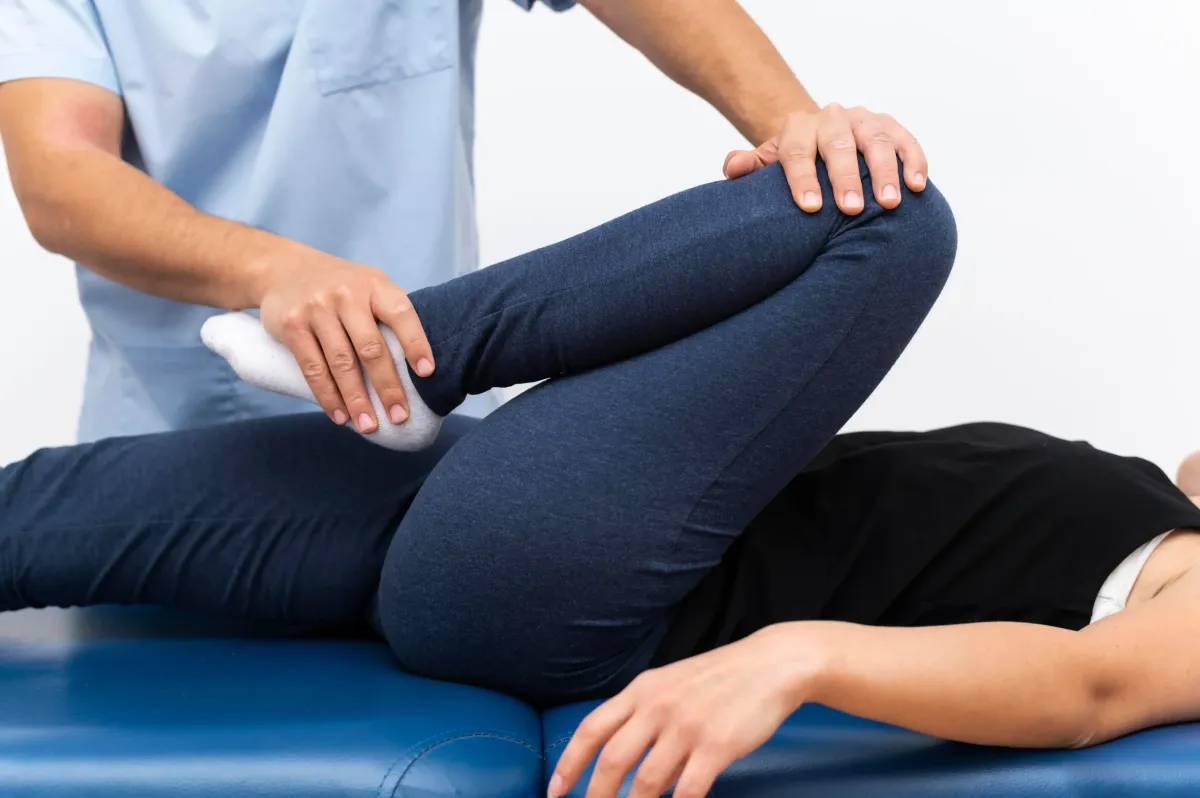Hip Labral Tear Treatment in NYC
Manhattan Physical Therapy

What Is a Hip Labral Tear?
A hip labral tear is an injury to the ring of cartilage lining the hip socket. This ring, called the labrum, keeps the joint stable and prevents friction between the thigh bone and pelvis. When the labrum is irritated or torn, the hip may feel painful, stiff, or unstable.
The hip is a ball-and-socket joint. The top of the thigh bone forms the “ball,” and the socket in the pelvis is called the acetabulum. The labrum reinforces this socket, allowing the bones to glide smoothly. When the labrum is damaged, the joint loses some of its natural cushioning, making movements less comfortable.
Labral tears can occur in the front (anterior) or back (posterior) of the joint. Anterior tears are more common, especially in people who sit for long periods or perform repetitive bending and twisting.
What Symptoms Should You Watch For?
Labral tear symptoms can vary depending on the severity of the injury. Many patients in NYC describe pain that feels deep inside the hip or groin rather than on the surface of the skin. Common signs include:
Persistent hip or groin pain during walking, bending, or exercise
Stiffness after long sitting or standing
Clicking, popping, or catching sensation
Feeling unsteady or unstable on one leg
Difficulty with activities such as running, cycling, or climbing stairs
Pain that radiates into the lower back or thigh
What Causes Hip Labral Tears?
Hip labral tears often result from conditions or movements that place excess stress on the joint. Understanding the causes can help patients prevent further injury and guide effective treatment. The most common causes include:
Femoroacetabular Impingement (FAI)
FAI is a structural condition in which the bones of the hip joint do not fit together perfectly. This misalignment can occur naturally or develop over time due to activity and stress. When the femoral head (thigh bone) and acetabulum (hip socket) rub against each other abnormally, it creates friction on the labrum. Over months or years, this repetitive irritation can gradually tear the labral tissue. People with FAI may experience stiffness, groin pain, and limited range of motion, often noticing discomfort during prolonged sitting, deep squats, or rotational movements.
Injuries and Trauma
Sudden or forceful movements can directly damage the labrum. Common causes include:
Bullet List 1· Sports injuries: Activities requiring rapid pivoting, twisting, or jumping—like soccer, hockey, ballet, and running—can strain the hip.
Falls or accidents: Landing awkwardly or taking a hard fall can tear the labrum.
Car accidents: Even minor collisions may cause enough impact to damage the cartilage.
Osteoarthritis
Osteoarthritis is a degenerative joint disease that gradually wears down cartilage over time. As the protective cartilage thins, the labrum becomes more exposed to friction and mechanical stress. Daily activities, repeated bending, prolonged standing, and even walking long distances in urban environments like New York City can contribute to joint wear. When the labrum is compromised, even minor movements can lead to tearing, creating pain, stiffness, and reduced mobility.
Other Contributing Factors
Certain lifestyle and anatomical factors may also increase the risk of labral tears, including:
Bullet List 1· Hip dysplasia: A shallow hip socket can place more stress on the labrum.· Hip dysplasia: A shallow hip socket can place more stress on the labrum.
Repetitive motion: Jobs or hobbies that involve frequent hip rotation or deep bending.
Muscle imbalances: Weak glutes, core, or hip stabilizers can allow the hip to move incorrectly, placing uneven pressure on the labrum.
How Do Providers Diagnose a Hip Labral Tear?
Accurate diagnosis is essential for effective treatment. During an evaluation at Manhattan Physical Therapy, your clinician will:
Ask detailed questions about your symptoms, activities, and how long the discomfort has been present
Assess your hip’s range of motion, strength, and stability
Perform gentle movement tests to identify positions that trigger pain
If imaging is needed, your doctor may recommend an X-ray, MRI, ultrasound, or CT scan to look closely at the joint and surrounding tissues. Imaging helps confirm whether the labrum is torn and whether other structures, such as cartilage or bone, are affected.
How Is a Hip Labral Tear Treated?
Most hip labral tears can be managed without surgery when treatment begins early. In New York City, many patients respond well to a combination of targeted physical therapy, activity modification, and strengthening exercises. The goal is to improve joint stability, reduce stress on the labrum, and restore comfortable movement.
Conservative care may include:
Therapeutic exercises
Hands-on manual therapy
Stretching to reduce muscle tension
Strengthening of core and hip stabilizers
Gait and posture correction
Activity guidance to avoid movements that aggravate the joint
Which Exercises Help Relieve Hip Labral Tear Pain?
Exercises for a hip labral tear focus on flexibility, stability, and balanced muscle strength. These movements help reduce pressure inside the joint and improve comfort during daily activities. Below are commonly recommended exercises:
1. Standing Hip Flexor Stretch
Tight hip flexors place excess stress on the joint. This stretch lengthens the front-hip muscles, reducing irritation around the labrum.
Step one foot forward
Shift your weight gently
Hold for 30 seconds
Repeat 3 times on each side
2. Kneeling Hip Flexor Stretch
Ideal for patients who prefer more support.
Kneel on one knee
Lean forward slightly
Hold for 30 seconds
Repeat 3 times on each side
3. Horizontal Squat Stretch
This helps loosen the hips, groin, and lower back.
Bullet List 1· Start on all fours
Spread your knees apart
Lower your hips back
Hold for 30–60 seconds
4. Standing or Sitting Inner Thigh Stretch
This reduces groin tightness that often worsens labral pain.
Shift weight to one side or use the butterfly position
Hold for 30 seconds
Repeat 3 times
5. Single-Leg Bridge
Strengthens the glutes and core to stabilize the hip.
Lie on your back
Extend one leg
Press through the opposite heel
Lift your hips for 2–5 seconds
Repeat 10 times
6. Standing Hip Abduction
Builds outer-hip strength to reduce strain on the labrum during walking.
Bullet List 1· Stand straight
Lift one leg out to the side
Hold for 2–3 seconds
Repeat 10 times
Your physical therapist will decide which exercises are appropriate based on your pain level, mobility, and posture. Movements should feel gentle—not sharp or uncomfortable.
When Is Surgery Needed for a Hip Labral Tear?
Surgery is usually considered when:
Targeting the body’s energy imbalances· Pain has not improved after several months of physical therapy
The tear is large or unstable
Structural problems like femoroacetabular impingement (FAI) are present
Hip function limits normal activities or sports
The most common surgical option is hip arthroscopy. During this minimally invasive procedure, an orthopedic surgeon uses a small camera to access the joint through tiny incisions. Depending on the need, they may:
Remove damaged tissue
Stitch the tear
Reconstruct the labrum using graft tissue
Reshape the hip bones if FAI is the cause
Recovery times vary, but physical therapy plays a major role in helping patients regain strength and motion after surgery. Call us at (212)-213-3480 to book your appointment and learn how our hip labral tear treatment program can help you move with confidence again.
What Do They Say About Us?
Alexander Liu
"Everyone on the team at Manhattan Physical Therapy is super nice and caring. They were able to pretty quickly diagnose my knee and hip problems and immediately put me to work to reduce the pain.."
Henry Myerberg
"You're not just a patient when you come to the Manhattan Physical Therapy. You feel like family there. In particular, Erica with her colleagues John, Lidia and Joe not only fix and improve you physically, they make you feel welcomed and cared for.."
Hakyung Kim
"Everyone is so kind and helpful! my knee and hip pain have improved massively since starting Manhattan PT, highly recommend to anyone. special thanks to Bianca, Lidia, Joe, and John!"
Manhattan Physical Therapy
✆ Phone (appointments):
(212) 213-3480
Address: 385 5th Ave, Suite 503, New York, NY 10016

